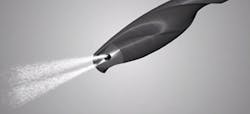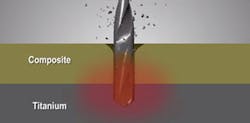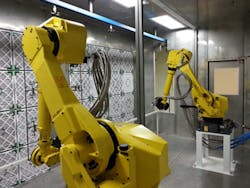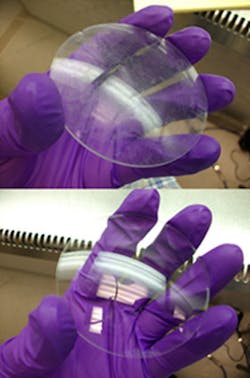Clean for Cooling
Liquid coolants have many benefits in machining, but they fall short when a work piece must remain dry. Machinists have tried to get around this problem by using cold air guns, but this dry method doesn’t lower temperatures quickly enough. Enter COâ as a viable alternative coolant.
COâ cooling delivers solid crystals of dry ice into the heat zone, where the tool and work piece meet, at a temperature of -110°F. The dry ice penetrates the vapor-heat barrier to improve heat transfer. This cooling effect keeps the cutting edge sharper and extends the tool’s life compared to conventional dry or minimum quantity lubrication processes. COâ coolant can be delivered in two ways: For drilling, it is delivered through ports in the tool. For milling and other machining processes, an external delivery is utilized.
In the aerospace and automotive industries, manufacturers who work with composites opt away from using conventional liquid fluid coolant. Composite have a porous surface which can trap coolant and requires an extensive cleaning procedure. Drilling composites dry eliminates the necessary cleaning, which is why using dry COâ cooling is acceptable—e.g., it cools without leaving behind any trace residue.
This process works well with stack ups. Using the example of a composite titanium stack up, a drill penetrates easily through the composite without creating much heat. Once it hits a titanium layer, however, the drill meets resistance and generates a significant amount of heat. The concern for manufacturers is that this heat buildup greatly diminishes tool life. In addition, metal chips exiting can damage the composite layer, resulting in poor hole tolerances and delamination.
COâ technology addresses both of these issues. First, the COâ moves through the drill, maintaining an ambient temperature. As the drill continues to move through the layers, it cools the hole—making it harder, and significantly reducing the damage done by the metal chips. Plus, the process remains completely dry while allowing tighter hole tolerances and increases in tool life.
Cool for Cleaning
COâ is also finding use as a cleaning agent. In the automotive industry, several major car makers have found that COâ cleaning saves them money and time while lowering their negative impact on the environment.
COâ is used for pretreatment of plastics; it can clean parts such as automotive trim, door handles, dashboards, and headlights, prior to a painting or coating. COâ spray effectively removes all contaminants that may affect the quality of the paint, such as light oils, water marks, dusts, and fingerprints.
COâ spray is delivered at pressures high enough to clean parts effectively, but low enough not to damage parts’ surfaces. Unlike traditional cleaning processes, COâ evaporates completely, leaving no residue to necessitate a second cleaning. It also cleans without condensation, so there is no need for cleaning zones in most plants. After cleaning with dry COâ, parts can move directly into painting/coating, saving energy and time associated with expensive drying processes.
Aqueous cleaning has been the norm for industries that relied on traditional methods for cleaning and sterilization. Although cleaning with water has been very successful in many applications, the process is showing drawbacks as newer materials, like porous implants, are adopted. Water-based cleaning uses water and ultrasonics to clean. Water can become trapped in the substrate after cleaning, leaving water spots. When that happens, an additional drying procedure is required.
Liquid COâ (LCOâ) provides a solution where a part is completely immersed and concealed in a highly pressurized vessel at around 600-900 psi. The low viscosity and surface tension of LCOâ lets it flow easily through porous parts, rinsing away contamination without leaving behind residue.
After pressure is released from the vessel, the COâ evaporates and a clean, dry, porous part remains—all in about 20 to 45 minutes. As an added environmental benefit, the COâ is recaptured after use, reducing the amount of energy used to recover it.
LCOâ can also be used to clean materials by extracting unwanted compounds (such as unreacted silicone oils) with minimal damage or denaturing. The biggest advantage of LCOâ is its low levels of toxicity. LCOâ cleaning works well on medical implants, catheters, silicone tubing, and silicone disks to outgas. Compared to expensive vacuum bake out systems, LCOâ takes significantly less time (1 to 6 hours, compared to 24 to 72 hours).
In summation, COâ is changing the manufacturing landscape in more ways than one. It’s time to start taking notice.
Jon Wikstrom is CEO of Cool Clean Technologies, Eagan, Minn.




